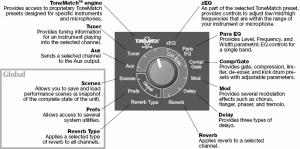Difference between revisions of "T1 ToneMatch® Audio Engine / Effects"
(first ed (note also transcluded to T1 page)) |
|||
| Line 1: | Line 1: | ||
{{T1 icon}} | {{T1 icon}} | ||
| + | [[Image:T1EffectsP19.png|thumb|right|Rotary Control showing effects]] | ||
| + | |||
| + | |||
Hilmar-at-Bose talks about the effects <ref>Hilmar-at-Bose [http://bose.infopop.cc/eve/forums?a=tpc&f=7521050644&m=8281092054&r=1111023054#1111023054 talks about the effects]</ref> | Hilmar-at-Bose talks about the effects <ref>Hilmar-at-Bose [http://bose.infopop.cc/eve/forums?a=tpc&f=7521050644&m=8281092054&r=1111023054#1111023054 talks about the effects]</ref> | ||
Revision as of 12:57, 27 May 2007
Hilmar-at-Bose talks about the effects [1]
There is a large variety of effect processors out there with many different types, qualities, and prices and unfortunately there isn't a one-size-fits approach. Not the least factor is that a lot depends on personal taste and preference.
Our intention with the T1 ToneMatch Audio Engine was not necessarily to build the "world's best effects" but solid usable tools that the musician can deploy in a live situation as the situation requires. We've evaluated effect processors that are popular for live performance and used that to guide our own development. We've also tried to limit the complexity of the user interface, i.e. we provide only the most useful parameters for a certain effect and have pre-tuned the more esoteric ones.
This being said, the T1 ToneMatch Audio Engine has a couple of things that are different from most effects processors: The processing power devoted to this is substantial. The processing chip we use operates in 32-bit floating point and has a peak performance of about 2 billion operations per second (2 GFlops). That is a lot more than can be found in typical processors of this type.
This enables us also to run individual effects on all 4 channels. You can use different combination of compressor/limiter, chorus/flanger, delay, parametric EQ, etc. on each channel. The only thing that is shared is reverb. This is equivalent of having pretty much 4 multi-effects processors at the same time. This enables the user to fine tune and tweak the effects settings for each individual instruments without having to compromise between channels.
There is also some fairly unique processing such as kick-gate (for drums), zEQ and ToneMatch™, that is not available from any other device I'm aware of.
Again, in the end each user will have to decide whether we have found the "sweet spot" or not, but I'm confident that these effects will work well for many users.
Hope that helps
Hilmar
- ↑ Hilmar-at-Bose talks about the effects

